
Sullivan's Island, historically known as O'Sullivan's Island, is a town and island in Charleston County, South Carolina, United States, at the entrance to Charleston Harbor, with a population of 1,791 at the 2010 census, and 1,891 people in 2020. The town is part of the Charleston metropolitan area, and is considered a very affluent suburb of Charleston.
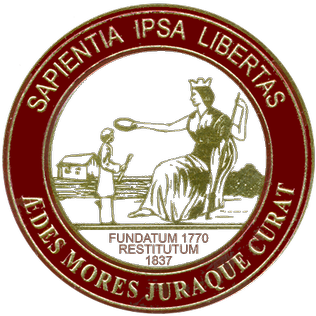
The College of Charleston is a public university in Charleston, South Carolina. Founded in 1770 and chartered in 1785, it is the oldest university in South Carolina, the 13th-oldest institution of higher learning in the United States, and the oldest municipal college in the nation.
Castle Pinckney is a small masonry fortification constructed by the United States government, in the harbor of Charleston, South Carolina in 1810. It was used very briefly as a prisoner-of-war camp and artillery position during the American Civil War. It was named to the National Register of Historic Places in 1970.
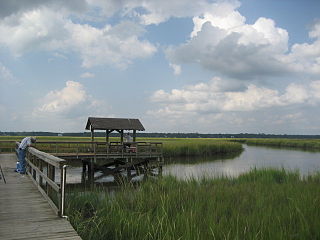
James Island is a town in Charleston County, South Carolina, United States. It is located in the central and southern parts of James Island. James Island is included within the Charleston-North Charleston-Summerville metropolitan area and the Charleston-North Charleston Urbanized Area.

McLeod Plantation is a former slave plantation located on James Island, South Carolina, near the intersection of Folly and Maybank roads at Wappoo Creek, which flows into the Ashley River. The plantation is considered an important Gullah heritage site, preserved in recognition of its cultural and historical significance to African-American and European-American cultures.
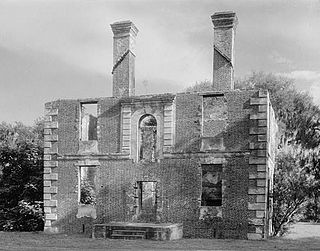
The Paul Hamilton House, commonly referred to as the Brick House Ruins, is the ruin of a 1725 plantation house on Edisto Island, South Carolina, that burned in 1929. It was designated a National Historic Landmark in 1970 for the unusual architecture of the surviving walls, which is partly based on French Huguenot architecture of the period.

The Old Exchange & Provost Dungeon, also known as the Custom House, and The Exchange, is a historic building at East Bay and Broad Streets in Charleston, South Carolina. Built in 1767–1771, it has served a variety of civic institutional functions, including notably as a prisoner of war facility operated by British forces during the American Revolutionary War. The building was designated a National Historic Landmark in 1973. It is now a museum operated by the Daughters of the American Revolution.

The Old Marine Hospital is a historic medical building at 20 Franklin Street in Charleston, South Carolina. Built 1831–33 to a design by Robert Mills, it was designated a National Historic Landmark in 1973 for its association with Mills, and as a high-quality example of Gothic Revival architecture. The hospital was built as a public facility for the treatment of sick sailors and other transient persons.
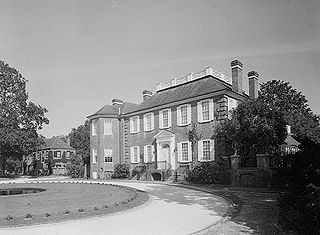
The Fenwick Hall, which is also known as Fenwick Castle, is a plantation house built about 1730 on Johns Island, South Carolina, across the Stono River from James Island and Charleston. It is located between River Road and Penneys Creek. It was named to the National Register of Historic Places on February 23, 1972.

The Josiah Smith Tennent House is a historic house in Charleston, South Carolina. The house was built by Josiah Smith Tennent in 1859 and placed on the National Register of Historic Places in 1979.

The Sword Gate House is a historic house in Charleston, South Carolina. Built in stages, the main portion of the house is believed to have been built around 1803, possibly by French Huguenots James LaRoche and J. Lardent. The house replaced a simpler house that was shown on a plat in 1803.

The Hutchinson House is the oldest identified house on Edisto Island, South Carolina associated with the black community after the American Civil War. It was the residence of Henry Hutchinson, a freedman who was a noteworthy post-war Sea Island Cotton planter.

Marshlands Plantation House, in Charleston, South Carolina, is an historic plantation house that was built in 1810 and listed in the National Register of Historic Places on March 30, 1973. It is a 2+1⁄2-story Federal-style plantation home. The house was relocated in the 1960s from its original location on the site of the United States Navy Shipyard. The Navy had announced it would have to demolish the empty house if it could not be relocated with the $15,000 the Navy had set aside for the purpose. The City of Charleston took temporary possession of the house, transferring it to the College of Charleston which relocated it for preservation to James Island.

Prospect Hill is an historic plantation house on Edisto Island, South Carolina. The two-story Federal house is significant for its architecture and ties to the production of sea island cotton. Constructed about 1800 for Ephraim Baynard, it sits on a bluff overlooking the South Edisto River. In 1860, William Grimball Baynard owned Prospect Hill. Baynard was an elder in the Edisto Island Presbyterian Church, a Justice of the Peace, a Justice of the Quorum, and the owner of 220 slaves. When Baynard died in 1861, his son William G. Baynard acquired the house. The house was listed in the National Register of Historic Places on 28 November 1986.
The Arnoldus Vander Horst House is a plantation house on Kiawah Island, South Carolina. It is named for Arnoldus Vanderhorst, who was a governor of South Carolina.
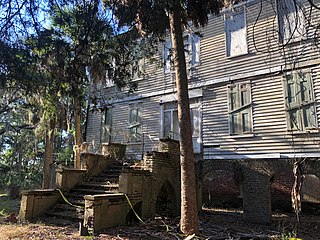
Peters Point Plantation is a historic structure located on Edisto Island, South Carolina. It was built by Isaac Jenkins Mikell in 1840 at the intersection of St. Pierre's Creek and Fishing Creek. It is located on the site General Lafayette used as a departure point from Edisto Island in 1826 during his southern tour.

Bailey's Store is one of the last nineteenth century commercial structures on Edisto Island, Charleston County, South Carolina. Bailey's Store was likely built earlier than 1825 on Edingsville Beach, a popular seaside resort, before it was moved to its present location about 1870 following the abandonment of Edingsville Beach. Because all of the remaining structures at Edingsville Beach were swept into the Atlantic Ocean in the hurricane of 1893, Bailey's Store is the only survivor of that community. The building was moved in two parts to Store Creek. It was reassembled there for use as a gin house already on that location. The building was listed in the National Register November 28, 1986.
Moving Star Hall is a historic community building located at Johns Island, Charleston County, South Carolina. It was built about 1917, and is a crudely built, one-story, rectangular, frame, weatherboarded building. It has a low concrete block pillar foundation and a metal-covered gable roof. Also on the property is a contributing outhouse. The building was used by the local African-American population as a "praise house" and meeting place of the Moving Star Young Association, a religious, social, fraternal, and charitable community institution.
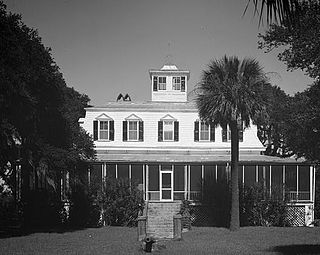
Sunnyside, also known as the Townsend Mikell House, is a historic plantation house located at Edisto Island, Charleston County, South Carolina. The main house was built about 1875, and is a 1+1⁄2-story, rectangular, frame, weatherboard-clad residence. It features a mansard roof topped by a cupola and one-story, hipped roof wraparound porch. Also on the property are the tabby foundation of a cotton gin; two small, rectangular, one-story, gable roof, weatherboard-clad outbuildings; a 1+1⁄2-story barn; and the Sunnyside Plantation Foreman's House. The Foreman's House is a two-story, weatherboard-clad, frame residence built about 1867.

The Mosquito Beach Historic District located on James Island, South Carolina was the weekend destination for thousands of African Americans during the height of Jim Crow. It was added to the National Historic Register on September 23, 2019. The 8.36-acre site, located between two creeks, was formerly owned by a member of the Legare family. In the 1950s, African Americans began using the land, which was more akin to a dirt road on a creek rather than a natural beach, for recreation. The four structures and corresponding pavilions were a safe refuge for the community. Usage of Mosquito Beach declined after nearby Folly Beach was desegregated.





















